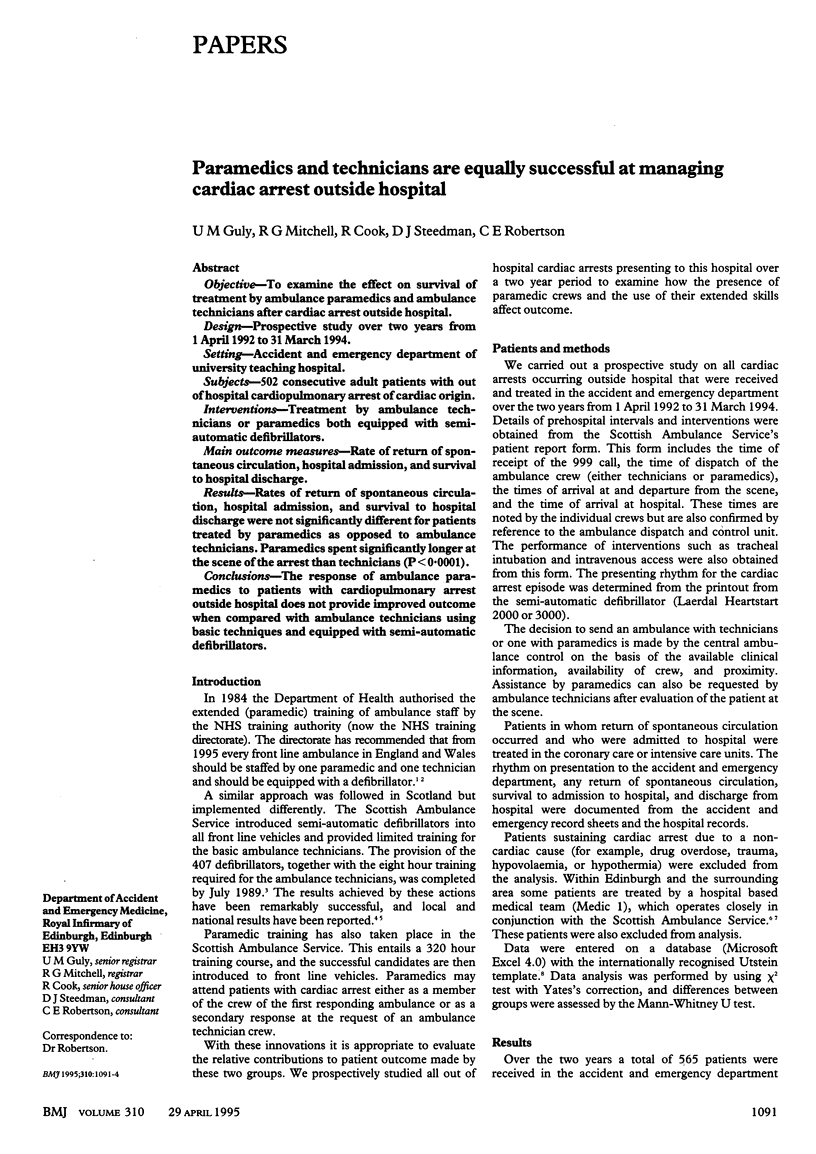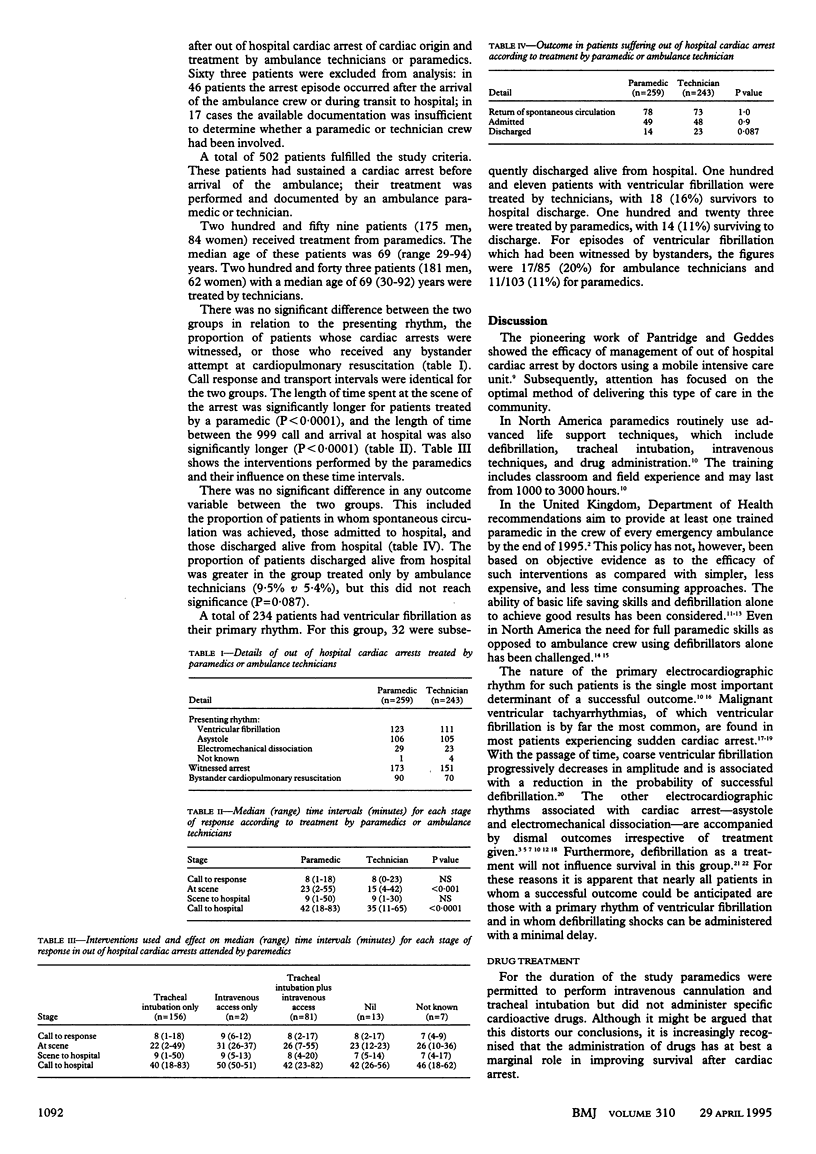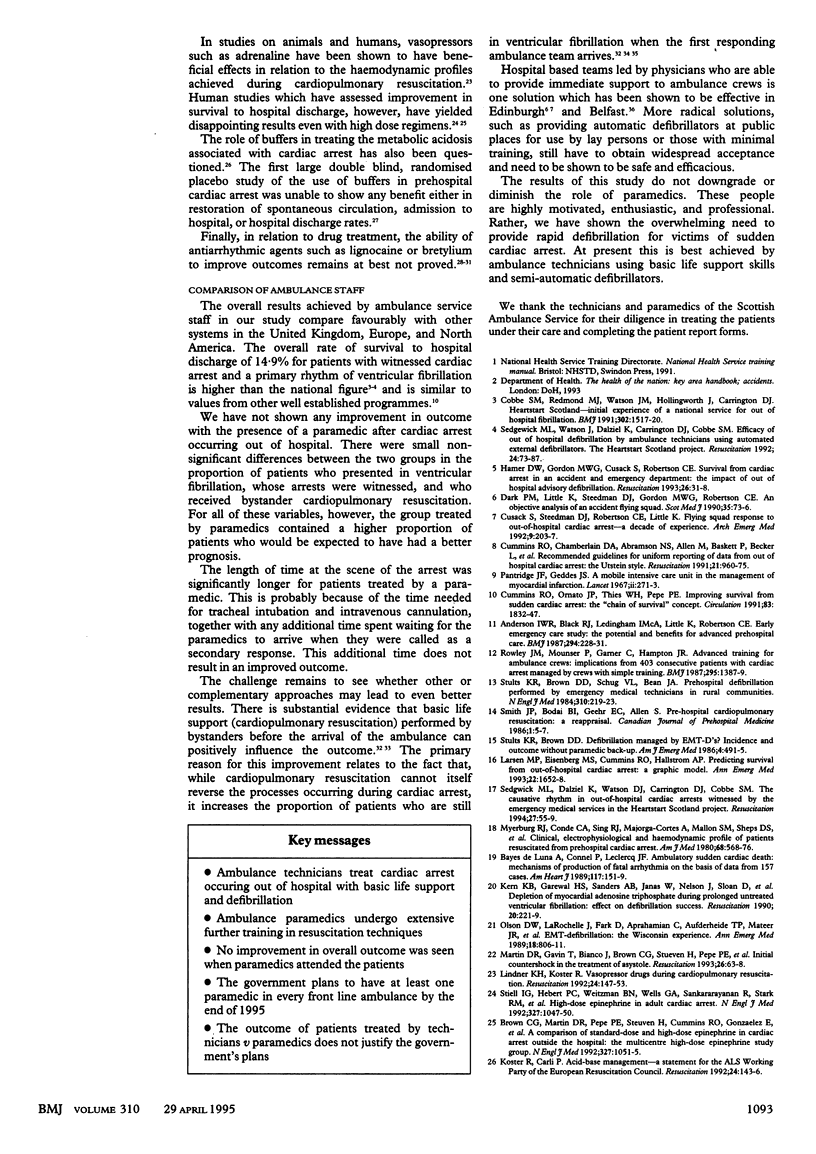Abstract
OBJECTIVE--To examine the effect on survival of treatment by ambulance paramedics and ambulance technicians after cardiac arrest outside hospital. DESIGN--Prospective study over two years from 1 April 1992 to 31 March 1994. SETTING--Accident and emergency department of university teaching hospital. SUBJECTS--502 consecutive adult patients with out of hospital cardiopulmonary arrest of cardiac origin. INTERVENTIONS--Treatment by ambulance technicians or paramedics both equipped with semiautomatic defibrillators. MAIN OUTCOME MEASURES--Rate of return of spontaneous circulation, hospital admission, and survival to hospital discharge. RESULTS--Rates of return of spontaneous circulation, hospital admission, and survival to hospital discharge were not significantly different for patients treated by paramedics as opposed to ambulance technicians. Paramedics spent significantly longer at the scene of the arrest than technicians (P < 0.0001). CONCLUSIONS--The response of ambulance paramedics to patients with cardiopulmonary arrest outside hospital does not provide improved outcome when compared with ambulance technicians using basic techniques and equipped with semi-automatic defibrillators.
Full text
PDF



Selected References
These references are in PubMed. This may not be the complete list of references from this article.
- Anderson I. W., Black R. J., Ledingham I. M., Little K., Robertson C. E., Urquhart J. D. Early emergency care study: the potential and benefits of advanced prehospital care. Br Med J (Clin Res Ed) 1987 Jan 24;294(6566):228–231. doi: 10.1136/bmj.294.6566.228. [DOI] [PMC free article] [PubMed] [Google Scholar]
- Bayés de Luna A., Coumel P., Leclercq J. F. Ambulatory sudden cardiac death: mechanisms of production of fatal arrhythmia on the basis of data from 157 cases. Am Heart J. 1989 Jan;117(1):151–159. doi: 10.1016/0002-8703(89)90670-4. [DOI] [PubMed] [Google Scholar]
- Brown C. G., Martin D. R., Pepe P. E., Stueven H., Cummins R. O., Gonzalez E., Jastremski M. A comparison of standard-dose and high-dose epinephrine in cardiac arrest outside the hospital. The Multicenter High-Dose Epinephrine Study Group. N Engl J Med. 1992 Oct 8;327(15):1051–1055. doi: 10.1056/NEJM199210083271503. [DOI] [PubMed] [Google Scholar]
- Cobbe S. M., Redmond M. J., Watson J. M., Hollingworth J., Carrington D. J. "Heartstart Scotland"--initial experience of a national scheme for out of hospital defibrillation. BMJ. 1991 Jun 22;302(6791):1517–1520. doi: 10.1136/bmj.302.6791.1517. [DOI] [PMC free article] [PubMed] [Google Scholar]
- Cummins R. O., Chamberlain D. A., Abramson N. S., Allen M., Baskett P. J., Becker L., Bossaert L., Delooz H. H., Dick W. F., Eisenberg M. S. Recommended guidelines for uniform reporting of data from out-of-hospital cardiac arrest: the Utstein Style. A statement for health professionals from a task force of the American Heart Association, the European Resuscitation Council, the Heart and Stroke Foundation of Canada, and the Australian Resuscitation Council. Circulation. 1991 Aug;84(2):960–975. doi: 10.1161/01.cir.84.2.960. [DOI] [PubMed] [Google Scholar]
- Cummins R. O., Ornato J. P., Thies W. H., Pepe P. E. Improving survival from sudden cardiac arrest: the "chain of survival" concept. A statement for health professionals from the Advanced Cardiac Life Support Subcommittee and the Emergency Cardiac Care Committee, American Heart Association. Circulation. 1991 May;83(5):1832–1847. doi: 10.1161/01.cir.83.5.1832. [DOI] [PubMed] [Google Scholar]
- Cusack S., Steedman D. J., Robertson C. E., Little K. Flying squad response to out-of-hospital cardiac arrest--a decade of experience. Arch Emerg Med. 1992 Jun;9(2):203–207. doi: 10.1136/emj.9.2.203. [DOI] [PMC free article] [PubMed] [Google Scholar]
- Dark P. M., Little K., Steedman D. J., Gordon M. W., Robertson C. E. An objective analysis of an accident flying squad. Scott Med J. 1990 Jun;35(3):73–76. doi: 10.1177/003693309003500304. [DOI] [PubMed] [Google Scholar]
- Dickey W., MacKenzie G., Adgey A. A. Long-term survival after resuscitation from ventricular fibrillation occurring before hospital admission. Q J Med. 1991 Sep;80(293):729–737. [PubMed] [Google Scholar]
- Garnett A. R., Glauser F. L., Ornato J. P. Hypercarbic arterial acidemia following resuscitation from severe hemorrhagic shock. Resuscitation. 1989 Feb;17(1):55–61. doi: 10.1016/0300-9572(89)90079-8. [DOI] [PubMed] [Google Scholar]
- Hamer D. W., Gordon M. W., Cusack S., Robertson C. E. Survival from cardiac arrest in an accident and emergency department: the impact of out of hospital advisory defibrillation. Resuscitation. 1993 Aug;26(1):31–37. doi: 10.1016/0300-9572(93)90160-r. [DOI] [PubMed] [Google Scholar]
- Harrison E. E. Lidocaine in prehospital countershock refractory ventricular fibrillation. Ann Emerg Med. 1981 Aug;10(8):420–423. doi: 10.1016/s0196-0644(81)80309-5. [DOI] [PubMed] [Google Scholar]
- Kern K. B., Garewal H. S., Sanders A. B., Janas W., Nelson J., Sloan D., Tacker W. A., Ewy G. A. Depletion of myocardial adenosine triphosphate during prolonged untreated ventricular fibrillation: effect on defibrillation success. Resuscitation. 1990 Dec;20(3):221–229. doi: 10.1016/0300-9572(90)90005-y. [DOI] [PubMed] [Google Scholar]
- Koster R., Carli P. Acid-base management. A statement for the Advanced Life Support Working Party of the European Resuscitation Council. Resuscitation. 1992 Nov;24(2):143–146. doi: 10.1016/0300-9572(92)90020-d. [DOI] [PubMed] [Google Scholar]
- Larsen M. P., Eisenberg M. S., Cummins R. O., Hallstrom A. P. Predicting survival from out-of-hospital cardiac arrest: a graphic model. Ann Emerg Med. 1993 Nov;22(11):1652–1658. doi: 10.1016/s0196-0644(05)81302-2. [DOI] [PubMed] [Google Scholar]
- Lindner K. H., Koster R. Vasopressor drugs during cardiopulmonary resuscitation. A statement for the Advanced Life Support Working Party of the European Resuscitation Council. Resuscitation. 1992 Nov;24(2):147–153. doi: 10.1016/0300-9572(92)90021-4. [DOI] [PubMed] [Google Scholar]
- Martin D. R., Gavin T., Bianco J., Brown C. G., Stueven H., Pepe P. E., Cummins R. O., Gonzalez E., Jastremski M. Initial countershock in the treatment of asystole. Resuscitation. 1993 Aug;26(1):63–68. doi: 10.1016/0300-9572(93)90164-l. [DOI] [PubMed] [Google Scholar]
- Myerburg R. J., Conde C. A., Sung R. J., Mayorga-Cortes A., Mallon S. M., Sheps D. S., Appel R. A., Castellanos A. Clinical, electrophysiologic and hemodynamic profile of patients resuscitated from prehospital cardiac arrest. Am J Med. 1980 Apr;68(4):568–576. doi: 10.1016/0002-9343(80)90307-1. [DOI] [PubMed] [Google Scholar]
- Olson D. W., LaRochelle J., Fark D., Aprahamian C., Aufderheide T. P., Mateer J. R., Hargarten K. M., Stueven H. A. EMT-defibrillation: the Wisconsin experience. Ann Emerg Med. 1989 Aug;18(8):806–811. doi: 10.1016/s0196-0644(89)80200-8. [DOI] [PubMed] [Google Scholar]
- Pantridge J. F., Geddes J. S. A mobile intensive-care unit in the management of myocardial infarction. Lancet. 1967 Aug 5;2(7510):271–273. doi: 10.1016/s0140-6736(67)90110-9. [DOI] [PubMed] [Google Scholar]
- Rowley J. M., Mounser P., Garner C., Hampton J. R. Advanced training for ambulance crews: implications from 403 consecutive patients with cardiac arrest managed by crews with simple training. Br Med J (Clin Res Ed) 1987 Nov 28;295(6610):1387–1389. doi: 10.1136/bmj.295.6610.1387. [DOI] [PMC free article] [PubMed] [Google Scholar]
- Schüttler J., Bremer F., Hörnchen U. Pharmakotherapie des Kammerflimmerns. Eine prospektive Studie im Notarztdienst. Anaesthesist. 1991 Mar;40(3):172–179. [PubMed] [Google Scholar]
- Sedgwick M. L., Dalziel K., Watson J., Carrington D. J., Cobbe S. M. The causative rhythm in out-of-hospital cardiac arrests witnessed by the emergency medical services in the Heartstart Scotland Project. Resuscitation. 1994 Jan;27(1):55–59. doi: 10.1016/0300-9572(94)90022-1. [DOI] [PubMed] [Google Scholar]
- Sedgwick M. L., Watson J., Dalziel K., Carrington D. J., Cobbe S. M. Efficacy of out of hospital defibrillation by ambulance technicians using automated external defibrillators. The Heartstart Scotland Project. Resuscitation. 1992 Aug-Sep;24(1):73–87. doi: 10.1016/0300-9572(92)90175-c. [DOI] [PubMed] [Google Scholar]
- Stults K. R., Brown D. D. Refibrillation managed by EMT-Ds: incidence and outcome without paramedic back-up. Am J Emerg Med. 1986 Nov;4(6):491–495. doi: 10.1016/S0735-6757(86)80001-8. [DOI] [PubMed] [Google Scholar]
- Stults K. R., Brown D. D., Schug V. L., Bean J. A. Prehospital defibrillation performed by emergency medical technicians in rural communities. N Engl J Med. 1984 Jan 26;310(4):219–223. doi: 10.1056/NEJM198401263100403. [DOI] [PubMed] [Google Scholar]
- Weaver W. D., Fahrenbruch C. E., Johnson D. D., Hallstrom A. P., Cobb L. A., Copass M. K. Effect of epinephrine and lidocaine therapy on outcome after cardiac arrest due to ventricular fibrillation. Circulation. 1990 Dec;82(6):2027–2034. doi: 10.1161/01.cir.82.6.2027. [DOI] [PubMed] [Google Scholar]
- von Planta M., Chamberlain D. Drug treatment of arrhythmias during cardiopulmonary resuscitation. A statement for the Advanced Life Support Working Party of the European Resuscitation Council. Resuscitation. 1992 Dec;24(3):227–232. doi: 10.1016/0300-9572(92)90182-c. [DOI] [PubMed] [Google Scholar]


